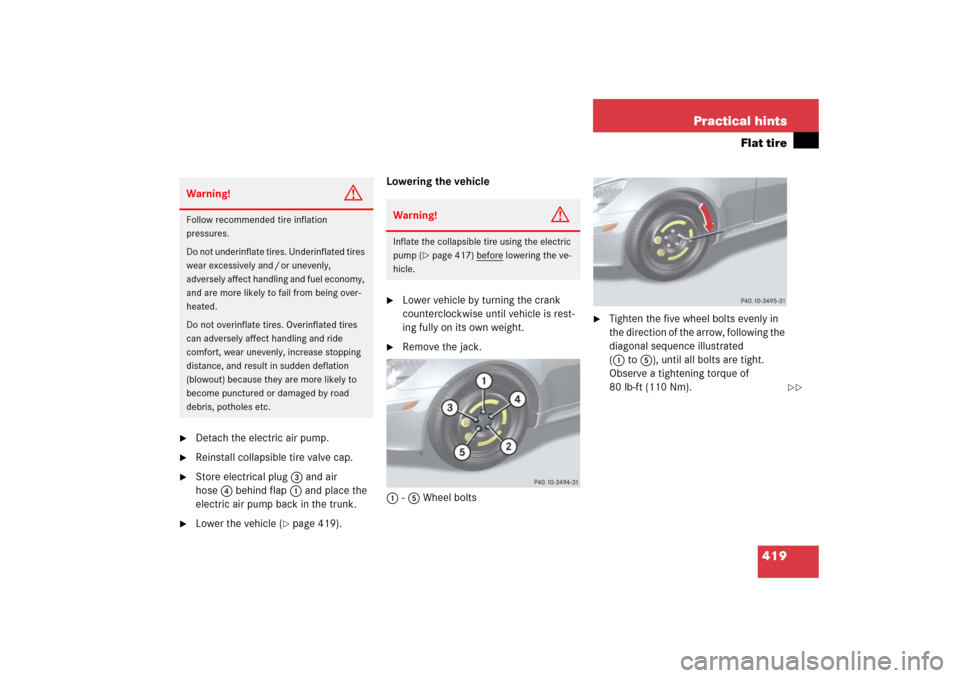Page 420 of 481

419 Practical hints
Flat tire
�
Detach the electric air pump.
�
Reinstall collapsible tire valve cap.
�
Store electrical plug3 and air
hose4 behind flap 1 and place the
electric air pump back in the trunk.
�
Lower the vehicle (
�page 419).Lowering the vehicle
�
Lower vehicle by turning the crank
counterclockwise until vehicle is rest-
ing fully on its own weight.
�
Remove the jack.
1-5 Wheel bolts
�
Tighten the five wheel bolts evenly in
the direction of the arrow, following the
diagonal sequence illustrated
(1to5), until all bolts are tight.
Observe a tightening torque of
80 lb-ft (110 Nm).
Warning!
G
Follow recommended tire inflation
pressures.
Do not underinflate tires. Underinflated tires
wear excessively and / or unevenly,
adversely affect handling and fuel economy,
and are more likely to fail from being over-
heated.
Do not overinflate tires. Overinflated tires
can adversely affect handling and ride
comfort, wear unevenly, increase stopping
distance, and result in sudden deflation
(blowout) because they are more likely to
become punctured or damaged by road
debris, potholes etc.
Warning!
G
Inflate the collapsible tire using the electric
pump (
�page 417) before
lowering the ve-
hicle.
��
Page 434 of 481
433 Technical data
Parts service
Warranty coverage
Identification labels
Layout of poly-V-belt drive
Engine
Rims and tires
Electrical system
Main Dimensions
Weights
Fuels, coolants, lubricants, etc.
Page 449 of 481
448 Technical dataWeightsModel
SLK 280
SLK 350
SLK 55 AMG
Maximum roof load
110lb (50kg)
110lb (50kg)
Maximum trunk load
220 lb (100 kg)
220 lb (100 kg)
!This vehicle is not designed to carry
items on its roof. Roof rails and any
roof-mounted devices, unless express-
ly approved by Mercedes-Benz for use
on this vehicle model, must not be used
as they will damage the vehicle and
retractable hardtop.
At time of printing, Mercedes-Benz
does not offer any roof racks or any
other roof-mounted devices for use on
this vehicle.
!This vehicle is not designed to carry
any items on its trunk lid or accommo-
date any type of trunk lid rack or de-
vice. Using such devices may damage
the vehicle and retractable hardtop
mechanism.
Page 458 of 481

457 Technical terms
ABS
(A
ntilock B
rake S
ystem)
Prevents the wheels from locking up
during braking so that the vehicle can
continue to be steered.
Accessory weight
(
�page 344)
Air pressure
(�page 344)
AIRSCARF neck-level heating*
AIRSCARF neck-level heating provides
the surrounding area of the occupants’
necks with a heated air stream flowing
from openings in the head restraints.
Alignment bolt
Metal pin with thread. The centering
pin is an aid used when changing a tire
to align the wheel with the wheel hub.
Aspect ratio
(�page 344)BabySmart
TM air bag deactivation
system
This system detects if a special
system-compatible child restraint seat
is installed on the passenger seat.
The system will automatically
deactivate the passenger front air bag
when such a seat is properly installed
(the 75indicator lamp
located in the center console comes on
and remains illuminated).
BabySmartTM compatible child seats
Special restraint system for children.
The sensor system for the passenger
seat prevents deployment of the pas-
senger front air bag if a BabySmart
TM
compatible child seat is installed. See
an authorized Mercedes-Benz Center
for availability.
Bar
(
�page 344)BAS
(B
rake A
ssist S
ystem)
System for potentially reducing braking
distances in emergency braking situa-
tions. The system is activated when it
senses an emergency based on how
fast the brake is applied.
Bead
(
�page 344)
Bi-Xenon headlamps*
Headlamps which use an electric arc as
the light source and produce a more in-
tense light than filament headlamps.
Bi-Xenon headlamps produce low
beam and high beam.
CAC
(Customer A
ssistance C
enter)
Mercedes-Benz customer service cen-
ter, which can help you with any ques-
tions about your vehicle and provide
assistance in the event of a break-
down.
Page 459 of 481

458 Technical termsCAN system
(C
ontroller A
rea N
etwork)
Data bus network serving to control ve-
hicle functions such as door locking or
windshield wiping.
Cockpit
All instruments, switches, buttons and
indicator/warning lamps in the passen-
ger compartment needed for vehicle
operation and monitoring.
Cold tire inflation pressure
(
�page 344)
Collapsible tire
An especially compact spare tire that
must be inflated with a provided air
pump before using. It should only be
used to bring the vehicle to the nearest
service station.COMAND*
(Co
ckpit Man
agement and
D
ata System)
Information and operating center for
vehicle sound and communications
systems, including the radio,
CD changer and navigation system, as
well as other optional equipment (e.g.
telephone).
Control system
The control system is used to call up
vehicle information and to change
component settings. Information and
messages appear in the multifunction
display. The driver uses the buttons on
the multifunction steering wheel to
navigate through the system and to ad-
just settings.
Cruise control
Driving convenience system for auto-
matically maintaining the vehicle speed
set by the driver.Curb weight
(
�page 344)
DOT
(Department o
f Transportation)
(
�page 344)
Engine number
The number set by the manufacturer
and placed on the cylinder block to
uniquely identify each engine pro-
duced.
Engine oil viscosity
Measurement for the inner friction (vis-
cosity) of the oil at different tempera-
tures. The higher the temperature an
oil can tolerate without becoming thin,
or the lower the temperature it can tol-
erate without becoming viscous, the
better the viscosity.
ESP®(Electronic S
tability Pr
ogram)
Improves vehicle handling and direc-
tional stability.
Page 461 of 481

460 Technical termsLine of fall
The direct line an object moves down-
hill when influenced by the force of
gravity alone.
Locking knob
Button on the door which indicates
whether the door is locked or un-
locked. Pushing the locking knob down
on an individual door from inside locks
that door.
Maintenance System (U.S. vehicles)
Maintenance service indicator in the
multifunction display that informs the
driver when the next vehicle mainte-
nance service is due. The Maintenance
System in your vehicle tracks distance
driven and the time elapsed since your
last maintenance service, and calls for
the next maintenance service accord-
ingly.Maximum loaded vehicle weight
(
�page 345)
Maximum load rating
(�page 345)
Maximum tire inflation pressure
(�page 345)
Memory function*
Used to store three individual seat,
steering wheel and mirror positions.
MON
(Motor O
ctane N
umber)
The Motor Octane Number for gasoline
as determined by a standardized
method. It is an indication of a gaso-
line’s ability to resist undesired detona-
tion (knocking). The average of both
the MON (Motor Octane Number) and
->RON (Research Octane Number) is
posted at the pump, also known as
ANTI-KNOCK INDEX.Multifunction display
Two display fields in the instrument
cluster used to present information
provided by the control system.
Multifunction steering wheel
Steering wheel with buttons for operat-
ing the control system.
Normal occupant weight
(
�page 345)
Overspeed range
Engine speeds within the red marking
of the tachometer dial. Avoid this
engine speed range, as it may result in
serious engine damage that is not
covered by the Mercedes-Benz Limited
Warranty.
Poly-V-belt drive
Drives engine components (alternator,
AC compressor, etc.) from the engine.
Page 462 of 481

461 Technical terms
Power train
Collective term designating all compo-
nents used to generate and transmit
motive power to the drive axles, includ-
ing
�
Engine
�
Clutch/torque converter
�
Transmission
�
Transfer case
�
Drive shaft
�
Differential
�
Axle shafts/axles
Production options weight
(
�page 345)Program mode selector switch*
Used to switch the automatic transmis-
sion between standard operation (S)
and comfort operation (C).
Vehicles with steering wheel gearshift
control and manual shift program: in
addition toS andC (for regularS
or comfortC operation, see above),
you can useM for manual shift pro-
gram.
PSI
(P
ounds per s
quare i
nch)
(
�page 345)
Recommended tire inflation pressure
(�page 345)REST
(Residual engine heat utilization)
Feature that uses the engine heat
stored in the coolant to heat the vehi-
cle interior for a short time after the en-
gine has been turned off.
Restraint systems
Seat belts, belt tensioners, air bags
and child restraint systems. As inde-
pendent systems, their protective func-
tions complement one another.
Rim
(
�page 345)
Retractable hardtop
Hardtop that can be opened and closed
at the push of a button and stored in
the trunk.
Page 464 of 481
463 Technical terms
Vehicle capacity weight
(
�page 346)
Vehicle maximum load on the tire
(�page 346)
VIN
(Vehicle I
dentification N
umber)
The number set by the manufacturer
and placed on the body to uniquely
identify each vehicle produced.
Wind screen
Screen for deflecting wind from the ve-
hicle interior when the hardtop is low-
ered.